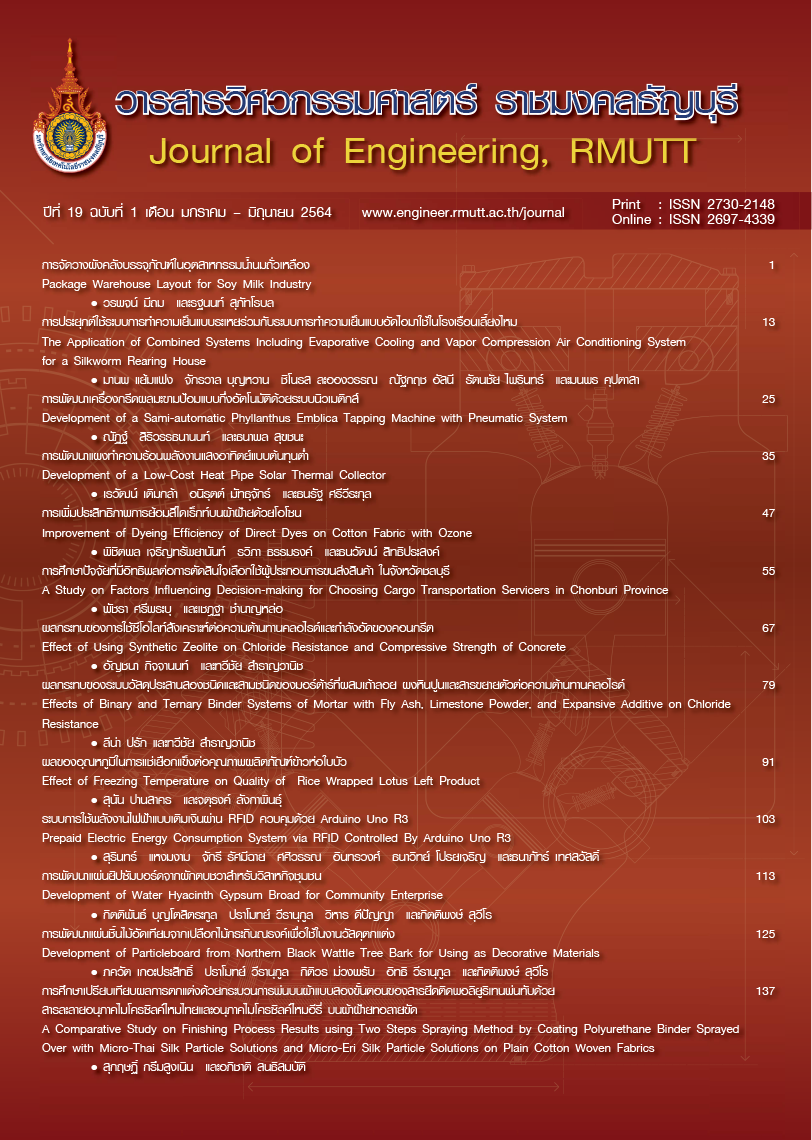The Application of Combined Systems Including Evaporative Cooling and Vapor Compression Air Conditioning System for a Silkworm Rearing House
Main Article Content
Abstract
This research was to study the changes of temperature and humidity in silk worm rearing house by using an evaporative cooling system in combination with a vapor compression air conditioning system. This study was tested in greenhouse with configuration of 10 x 21 x 3 m. For evaporative cooling system, six sections of evaporative cooling of 1.5 x 1.8 x 0.15 m each were installed on the south wall of the house and six exhaust fans with diameter of 30 inches were installed on the north wall of the house. For the vapor compression cooling system, four air conditioners of 30,000 Btu/hr were used. The experimental results from the house with evaporative cooling for worm periods 1, 2 and 3 found that the average differences of suitable temperature for those worms were 0.4oC, 1.0oC and 1.9oC, respectively. For the relative humidity, the average differences were 6.09%, 0.61% and 3.29%, respectively. The experimental results from the house with the vapor compression cooling system for worm periods 4 and 5 found that the average differences of appropriate temperature and humidity were 2.2oC, 0.33% for worm period 4 and 3.1oC ,4.86% for worm period 5.
Article Details
The manuscript, information, content, picture and so forth which were published on Frontiers in engineering innovation research has been a copyright of this journal only. There is not allow anyone or any organize to duplicate all content or some document for unethical publication.
References
Chuprayoon S. Silk production techniques. Department of Agricultural Extension. 80 p.
John A, Zahra Giabaklou. A passive evaporative cooling system by natural ventilation. Building and Environment. 1996;31(6):503-7.
Dai Y.J, Sumathy K. Theoretical study on a cross–flow direct evaporative cooler using honeycomb paper as packing material. Applied Thermal Engineering. 2002;(22): 1417-30.
Maheshwari G.P, Al-Ragom F, Suri R.K. Energy-saving potential of an indirect evaporative cooler. Applied Energy. 2001;(69):69-76.
Faleh Al-Sulaiman. Evaluation of the performance of local fibers in evaporative cooling. Energy Conversion and Management. 2002;(43):2267-73.
Hisham T.A, El-Dessouky, Amir A.Al-Haddad, Faisal Al-Juwayhel. Thermal and hydraulic performance of a modifide two-stage evaporative cooler. Renewable Energy. 1996;7(2):165-76.
Jain J.K, Hindoliya D.A. Experimental performance of new evaporative cooling pad materials. Sustainable Cities and Society. 2011;(1): 252-6.
Pervin A.D, Saffa R, Guohui G, Devrim A. Experimental study of the potential of eucalyptus fibres for evaporative cooling. Renewable Energy. 2019;(131):250-60.
Xu J, Li Y, Wang R.Z, Liu W, Zhou P. Experimental performance of evaporative cooling pad systems in greenhouses in humid subtropical climates. Applied Energy. 2015; (138):291-301.
Singh A, Kumar S, Dev R. Studies on cocopeat, sawdust and dried cow dung as desiccant for evaporative cooling system. Renewable Energy. 2019;(142):295-303.


